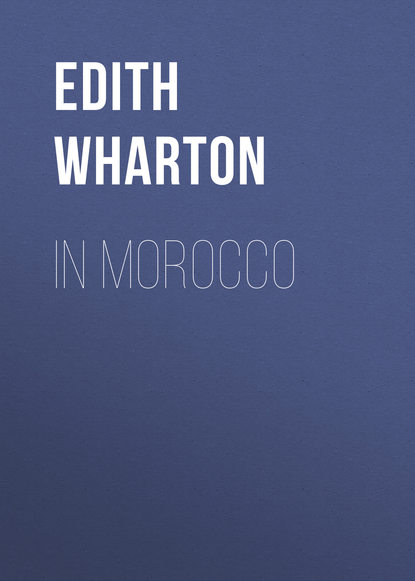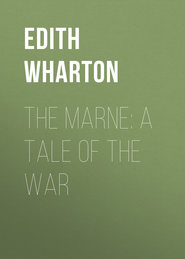По всем вопросам обращайтесь на: info@litportal.ru
(©) 2003-2024.
✖
In Morocco
Настройки чтения
Размер шрифта
Высота строк
Поля
The European town of Rabat, a rapidly developing community, lies almost wholly outside the walls of the old Arab city. The latter, founded in the twelfth century by the great Almohad conqueror of Spain, Yacoub-el-Mansour, stretches its mighty walls to the river's mouth. Thence they climb the cliff to enclose the Kasbah[3 - Citadel.] of the Oudayas, a troublesome tribe whom one of the Almohad Sultans, mistrusting their good faith, packed up one day, flocks, tents and camels, and carried across the bled to stow them into these stout walls under his imperial eye. Great crenellated ramparts, cyclopean, superb, follow the curve of the cliff. On the landward side they are interrupted by a gate-tower resting on one of the most nobly decorated of the horseshoe arches that break the mighty walls of Moroccan cities. Underneath the tower the vaulted entrance turns, Arab fashion, at right angles, profiling its red arch against darkness and mystery. This bending of passages, so characteristic a device of the Moroccan builder, is like an architectural expression of the tortuous secret soul of the land.
Outside the Kasbah a narrow foot-path is squeezed between the walls and the edge of the cliff. Toward sunset it looks down on a strange scene. To the south of the citadel the cliff descends to a long dune sloping to a sand-beach; and dune and beach are covered with the slanting headstones of the immense Arab cemetery of El Alou. Acres and acres of graves fall away from the red ramparts to the grey sea; and breakers rolling straight from America send their spray across the lowest stones.
There are always things going on toward evening in an Arab cemetery. In this one, travellers from the bled are camping in one corner, donkeys grazing (on heaven knows what), a camel dozing under its pack; in another, about a new-made grave, there are ritual movements of muffled figures and wailings of a funeral hymn half drowned by the waves. Near us, on a fallen headstone, a man with a thoughtful face sits chatting with two friends and hugging to his breast a tiny boy who looks like a grasshopper in his green caftan; a little way off, a solitary philosopher, his eye fixed on the sunset, lies on another grave, smoking his long pipe of kif.
There is infinite sadness in this scene under the fading sky, beside the cold welter of the Atlantic. One seems to be not in Africa itself, but in the Africa that northern crusaders may have dreamed of in snow-bound castles by colder shores of the same ocean. This is what Moghreb must have looked like to the confused imagination of the Middle Ages, to Norman knights burning to ransom the Holy Places, or Hansa merchants devising, in steep-roofed towns, of Barbary and the long caravans bringing apes and gold-powder from the south.
Inside the gate of the Kasbah one comes on more waste land and on other walls—for all Moroccan towns are enclosed in circuit within circuit of battlemented masonry. Then, unexpectedly, a gate in one of the inner walls lets one into a tiled court enclosed in a traceried cloister and overlooking an orange-grove that rises out of a carpet of roses. This peaceful and well-ordered place is the interior of the Medersa (the college) of the Oudayas. Morocco is full of these colleges, or rather lodging-houses of the students frequenting the mosques; for all Mahometan education is given in the mosque itself, only the preparatory work being done in the colleges. The most beautiful of the Medersas date from the earlier years of the long Merinid dynasty (1248-1548), the period at which Moroccan art, freed from too distinctively Spanish and Arab influences, began to develop a delicate grace of its own as far removed from the extravagance of Spanish ornament as from the inheritance of Roman-Byzantine motives that the first Moslem invasion had brought with it from Syria and Mesopotamia.
These exquisite collegiate buildings, though still in use whenever they are near a well-known mosque, have all fallen into a state of sordid disrepair. fortunately to build in the old tradition, which has never been lost—has, like all Orientals, an invincible repugnance to repairing and restoring, and one after another the frail exposed Arab structures, with their open courts and badly constructed terrace-roofs, are crumbling into ruin. Happily the French Government has at last been asked to intervene, and all over Morocco the Medersas are being repaired with skill and discretion. That of the Oudayas is already completely restored, and as it had long fallen into disuse it has been transformed by the Ministry of Fine Arts into a museum of Moroccan art.
The plan of the Medersas is always much the same: the eternal plan of the Arab house, built about one or more arcaded courts, with long narrow rooms enclosing them on the ground floor, and several stories above, reached by narrow stairs, and often opening on finely carved cedar galleries. The chief difference between the Medersa and the private house, or even the fondak,[4 - The Moroccan inn or caravanserai.] lies in the use to which the rooms are put. In the Medersas, one of the ground-floor apartments is always fitted up as a chapel, and shut off from the court by carved cedar doors still often touched with old gilding and vermilion. There are always a few students praying in the chapel, while others sit in the doors of the upper rooms, their books on their knees, or lean over the carved galleries chatting with their companions who are washing their feet at the marble fountain in the court, preparatory to entering the chapel.
In the Medersa of the Oudayas, these native activities have been replaced by the lifeless hush of a museum. The rooms are furnished with old rugs, pottery, brasses, the curious embroidered hangings which line the tents of the chiefs, and other specimens of Arab art. One room reproduces a barber's shop in the bazaar, its benches covered with fine matting, the hanging mirror inlaid with mother-of-pearl, the razor-handles of silver niello. The horseshoe arches of the outer gallery look out on orange-blossoms, roses and the sea. It is all beautiful, calm and harmonious; and if one is tempted to mourn the absence of life and local colour, one has only to visit an abandoned Medersa to see that, but for French intervention, the charming colonnades and cedar chambers of the college of the Oudayas would by this time be a heap of undistinguished rubbish—for plaster and rubble do not "die in beauty" like the firm stones of Rome.
V
ROBINSON CRUSOE'S "SALLEE"
Before Morocco passed under the rule of the great governor who now administers it, the European colonists made short work of the beauty and privacy of the old Arab towns in which they established themselves.
On the west coast, especially, where the Mediterranean peoples, from the Phenicians to the Portuguese, have had trading-posts for over two thousand years, the harm done to such seaboard towns as Tangier, Rabat and Casablanca is hard to estimate. The modern European colonist apparently imagined that to plant his warehouses, cafés and cinema-palaces within the walls which for so long had fiercely excluded him was the most impressive way of proclaiming his domination.
Under General Lyautey such views are no longer tolerated. Respect for native habits, native beliefs and native architecture is the first principle inculcated in the civil servants attached to his administration. Not only does he require that the native towns shall be kept intact, and no European building erected within them; a sense of beauty not often vouchsafed to Colonial governors causes him to place the administration buildings so far beyond the walls that the modern colony grouped around them remains entirely distinct from the old town, instead of growing out of it like an ugly excrescence.
The Arab quarter of Rabat was already irreparably disfigured when General Lyautey came to Morocco; but ferocious old Salé, Phenician counting-house and breeder of Barbary pirates, had been saved from profanation by its Moslem fanaticism. Few Christian feet had entered its walls except those of the prisoners who, like Robinson Crusoe, slaved for the wealthy merchants in its mysterious terraced houses. Not till two or three years ago was it completely pacified; and when it opened its gates to the infidel it was still, as it is to-day, the type of the untouched Moroccan city—so untouched that, with the sunlight irradiating its cream-coloured walls and the blue-white domes above them, it rests on its carpet of rich fruit-gardens like some rare specimen of Arab art on a strip of old Oriental velvet.
Within the walls, the magic persists: which does not always happen when one penetrates into the mirage-like cities of Arabian Africa. Salé has the charm of extreme compactness. Crowded between the river-mouth and the sea, its white and pale-blue houses almost touch across the narrow streets, and the reed-thatched bazaars seem like miniature reductions of the great trading labyrinths of Tunis or Fez.
Everything that the reader of the Arabian Nights expects to find is here: the whitewashed niches wherein pale youths sit weaving the fine mattings for which the town is still famous; the tunnelled passages where indolent merchants with bare feet crouch in their little kennels hung with richly ornamented saddlery and arms, or with slippers of pale citron leather and bright embroidered babouches; the stalls with fruit, olives, tunny-fish, vague syrupy sweets, candles for saints' tombs, Mantegnesque garlands of red and green peppers, griddle-cakes sizzling on red-hot pans, and all the varied wares and cakes and condiments that the lady in the tale of the Three Calanders went out to buy, that memorable morning in the market of Bagdad.
Only at Salé all is on a small scale: there is not much of any one thing, except of the exquisite matting. The tide of commerce has ebbed from the intractable old city, and one feels, as one watches the listless purchasers in her little languishing bazaars, that her long animosity against the intruder has ended by destroying her own life.
The feeling increases when one leaves the bazaar for the streets adjoining it. An even deeper hush than that which hangs over the well-to-do quarters of all Arab towns broods over these silent thorough-fares, with heavy-nailed doors barring half-ruined houses. In a steep deserted square one of these doors opens its panels of weather-silvered cedar on the court of the frailest, ghostliest of Medersas—mere carved and painted shell of a dead house of learning. Mystic interweavings of endless lines, patient patterns interminably repeated in wood and stone and clay, all are here, from the tessellated paving of the court to the honeycombing of the cedar roof through which a patch of sky shows here and there like an inset of turquoise tiling.
This lovely ruin is in the safe hands of the French Fine Arts administration, and soon the wood-carvers and stucco-workers of Fez will have revived its old perfection; but it will never again be more than a show-Medersa, standing empty and unused beside the mosque behind whose guarded doors and high walls one guesses that the old religious fanaticism of Salé is dying also, as her learning and her commerce have died.
In truth the only life in her is centred in the market-place outside the walls, where big expanding Rabat goes on certain days to provision herself. The market of Salé, though typical of all Moroccan markets, has an animation and picturesqueness of its own. Its rows of white tents pitched on a dusty square between the outer walls and the fruit-gardens make it look as though a hostile tribe had sat down to lay siege to the town; but the army is an army of hucksters, of farmers from the rich black lands along the river, of swarthy nomads and leather-gaitered peasant women from the hills, of slaves and servants and tradesmen from Rabat and Salé; a draped, veiled, turbaned mob shrieking, bargaining, fist-shaking, call on Allah to witness the monstrous villanies of the misbegotten miscreants they are trading with, and then, struck with the mysterious Eastern apathy, sinking down in languid heaps of muslin among the black figs, purple onions and rosy melons, the fluttering hens, the tethered goats, the whinnying foals, that are all enclosed in an outer circle of folded-up camels and of mules dozing under faded crimson saddles.
VI
CHELLA AND THE GREAT MOSQUE
The Merinid Sultans of Rabat had a terribly troublesome neighbour across the Bou-Regreg, and they built Chella to keep an eye on the pirates of Salé. But Chella has fallen like a Babylonian city triumphed over by the prophets; while Salé, sly, fierce and irrepressible, continued till well on in the nineteenth century to breed pirates and fanatics.
The ruins of Chella lie on the farther side of the plateau above the native town of Rabat. The mighty wall enclosing them faces the city wall of Rabat, looking at it across one of those great red powdery wastes which seem, in this strange land, like death and the desert forever creeping up to overwhelm the puny works of man.
The red waste is scored by countless trains of donkeys carrying water from the springs of Chella, by long caravans of mules and camels, and by the busy motors of the French administration; yet there emanates from it an impression of solitude and decay which even the prosaic tinkle of the trams jogging out from the European town to the Exhibition grounds above the sea cannot long dispel.
Perpetually, even in the new thriving French Morocco, the outline of a ruin or the look in a pair of eyes shifts the scene, rends the thin veil of the European Illusion, and confronts one with the old grey Moslem reality. Passing under the gate of Chella, with its richly carved corbels and lofty crenellated towers, one feels one's self thus completely reabsorbed into the past.
Below the gate the ground slopes away, bare and blazing, to a hollow where a little blue-green minaret gleams through fig-trees, and fragments of arch and vaulting reveal the outline of a ruined mosque.
Was ever shade so blue-black and delicious as that of the cork-tree near the spring where the donkey's water-cans are being filled? Under its branches a black man in a blue shirt lies immovably sleeping in the dust. Close by women and children splash and chatter about the spring, and the dome of a saint's tomb shines through lustreless leaves. The black man, the donkeys, the women and children, the saint's dome, are all part of the inimitable Eastern scene in which inertia and agitation are so curiously combined, and a surface of shrill noise flickers over depths of such unfathomable silence.
The ruins of Chella belong to the purest period of Moroccan art. The tracery of the broken arches is all carved in stone or in glazed turquoise tiling, and the fragments of wall and vaulting have the firm elegance of a classic ruin. But what would even their beauty be without the leafy setting of the place? The "unimaginable touch of Time" gives Chella its peculiar charm: the aged fig-tree clamped in uptorn tiles and thrusting gouty arms between the arches; the garlanding of vines flung from column to column; the secret pool to which childless women are brought to bathe, and where the tree springing from a cleft of the steps is always hung with the bright bits of stuff which are the votive offerings of Africa.
The shade, the sound of springs, the terraced orange-garden with irises blooming along channels of running water, all this greenery and coolness in the hollow of a fierce red hill make Chella seem, to the traveller new to Africa, the very type and embodiment of its old contrasts of heat and freshness, of fire and languor. It is like a desert traveller's dream in his last fever.
Yacoub-el-Mansour was the fourth of the great Almohad Sultans who, in the twelfth century, drove out the effete Almoravids, and swept their victorious armies from Marrakech to Tunis and from Tangier to Madrid. His grandfather, Abd-el-Moumen, had been occupied with conquest and civic administration. It was said of his rule that "he seized northern Africa to make order prevail there"; and in fact, out of a welter of wild tribes confusedly fighting and robbing he drew an empire firmly seated and securely governed, wherein caravans travelled from the Atlas to the Straits without fear of attack, and "a soldier wandering through the fields would not have dared to pluck an ear of wheat."
His grandson, the great El-Mansour, was a conqueror too; but where he conquered he planted the undying seed of beauty. The victor of Alarcos, the soldier who subdued the north of Spain, dreamed a great dream of art. His ambition was to bestow on his three capitals, Seville, Rabat and Marrakech, the three most beautiful towers the world had ever seen; and if the tower of Rabat had been completed, and that of Seville had not been injured by Spanish embellishments, his dream would have been realized.
The "Tower of Hassan," as the Sultan's tower is called, rises from the plateau above old Rabat, overlooking the steep cliff that drops down to the last winding of the Bou-Regreg. Truncated at half its height, it stands on the edge of the cliff, a far-off beacon to travellers by land and sea. It is one of the world's great monuments, so sufficient in strength and majesty that until one has seen its fellow, the Koutoubya of Marrakech, one wonders if the genius of the builder could have carried such perfect balance of massive wall-spaces and traceried openings to a triumphant completion.
Near the tower, the red-brown walls and huge piers of the mosque built at the same time stretch their roofless alignment beneath the sky. This mosque, before it was destroyed, must have been one of the finest monuments of Almohad architecture in Morocco: now, with its tumbled red masses of masonry and vast cisterns overhung by clumps of blue aloes, it still forms a ruin of Roman grandeur.
The Mosque, the Tower, the citadel of the Oudayas, and the mighty walls and towers of Chella, compose an architectural group as noble and complete as that of some mediæval Tuscan city. All they need to make the comparison exact is that they should have been compactly massed on a steep hill, instead of lying scattered over the wide spaces between the promontory of the Oudayas and the hillside of Chella.
The founder of Rabat, the great Yacoub-el-Mansour, The Moroccan Arab, though he continues to build—and called it, in memory of the battle of Alarcos, "The Camp of Victory" (Ribat-el-Path), and the monuments he bestowed on it justified the name in another sense, by giving it the beauty that lives when battles are forgotten.
II
VOLUBILIS, MOULAY IDRISS AND MEKNEZ
I
VOLUBILIS
One day before sunrise we set out from Rabat for the ruins of Roman Volubilis.
From the ferry of the Bou-Regreg we looked backward on a last vision of orange ramparts under a night-blue sky sprinkled with stars; ahead, over gardens still deep in shadow, the walls of Salé were passing from drab to peach-colour in the eastern glow. Dawn is the romantic hour in Africa. Dirt and dilapidation disappear under a pearly haze, and a breeze from the sea blows away the memory of fetid markets and sordid heaps of humanity. At that hour the old Moroccan cities look like the ivory citadels in a Persian miniature, and the fat shopkeepers riding out to their vegetable-gardens like Princes sallying forth to rescue captive maidens.
Our way led along the highroad from Rabat to the modern port of Kenitra, near the ruins of the Phenician colony of Mehedyia. Just north of Kenitra we struck the trail, branching off eastward to a European village on the light railway between Rabat and Fez, and beyond the railway-sheds and flat-roofed stores the wilderness began, stretching away into clear distances bounded by the hills of the Rarb,[5 - The high plateau-and-hill formation between Tangier and Fez.] above which the sun was rising.
Range after range these translucent hills rose before us; all around the solitude was complete. Village life, and even tent life, naturally gathers about a river-bank or a spring; and the waste we were crossing was of waterless sand bound together by a loose desert growth. Only an abandoned well-curb here and there cast its blue shadow on the yellow bled, or a saint's tomb hung like a bubble between sky and sand. The light had the preternatural purity which gives a foretaste of mirage: it was the light in which magic becomes real, and which helps to understand how, to people living in such an atmosphere, the boundary between fact and dream perpetually fluctuates.
The sand was scored with tracks and ruts innumerable, for the road between Rabat and Fez is travelled not only by French government motors but by native caravans and trains of pilgrims to and from the sacred city of Moulay Idriss, the founder of the Idrissite dynasty, whose tomb is in the Zerhoun, the mountain ridge above Volubilis. To untrained eyes it was impossible to guess which of the trails one ought to follow; and without much surprise we suddenly found the motor stopping, while its wheels spun round vainly in the loose sand.
The military chauffeur was not surprised either; nor was Captain de M., the French staff-officer who accompanied us.
"It often happens just here," they admitted philosophically. "When the General goes to Meknez he is always followed by a number of motors, so that if his own is stuck he may go on in another."
This was interesting to know, but not particularly helpful, as the General and his motors were not travelling our way that morning. Nor was any one else, apparently. It is curious how quickly the bled empties itself to the horizon if one happens to have an accident in it! But we had learned our lesson between Tangier and Rabat, and were able to produce a fair imitation of the fatalistic smile of the country.
The officer remarked cheerfully that somebody might turn up, and we all sat down in the bled.
A Berber woman, cropping up from nowhere, came and sat beside us. She had the thin sun-tanned face of her kind, brilliant eyes touched with khol, high cheek-bones, and the exceedingly short upper lip which gives such charm to the smile of the young nomad women. Her dress was the usual faded cotton shift, hooked on the shoulders with brass or silver clasps (still the antique fibulæ), and wound about with a vague drapery in whose folds a brown baby wriggled.










